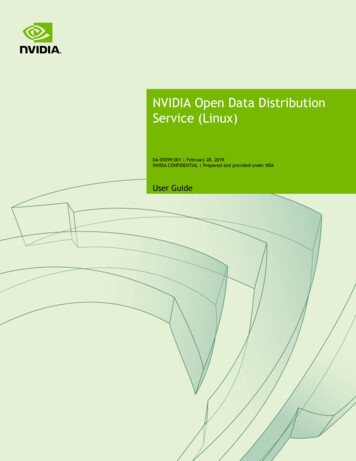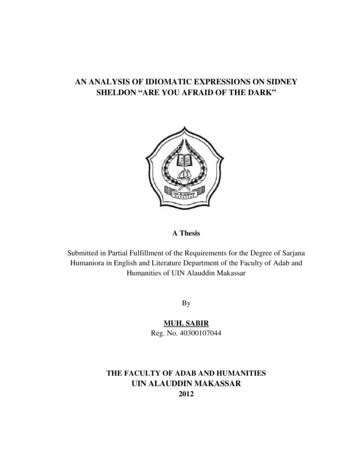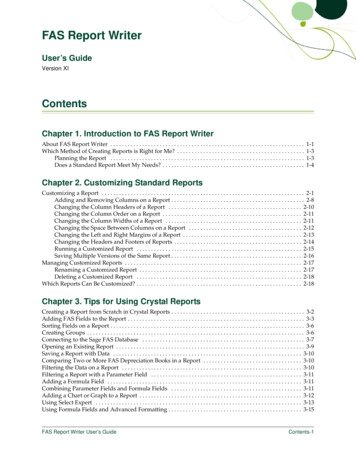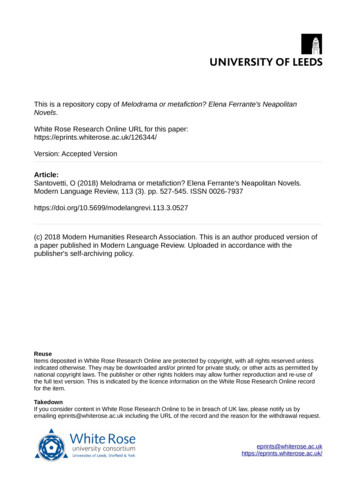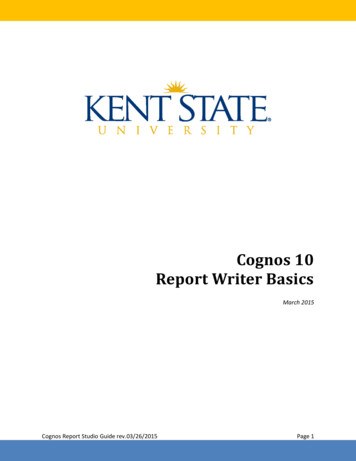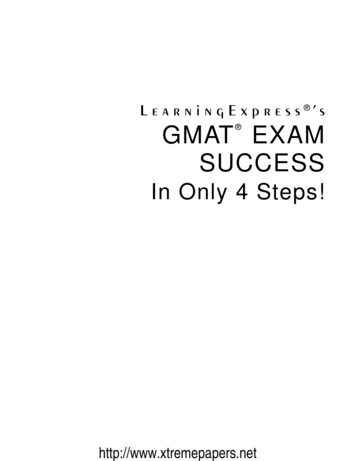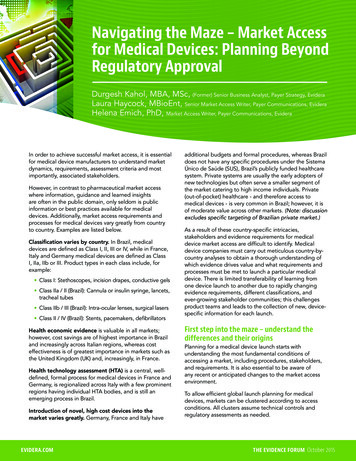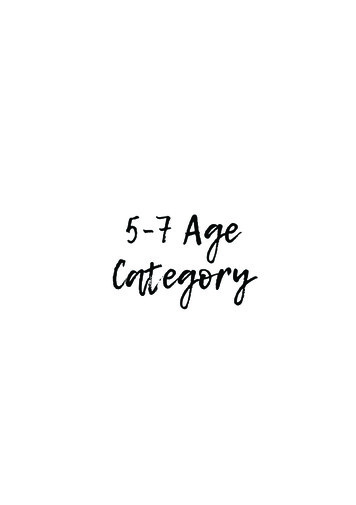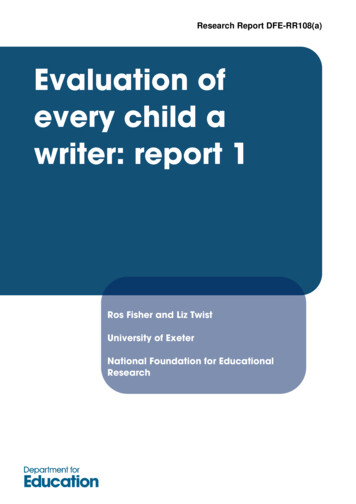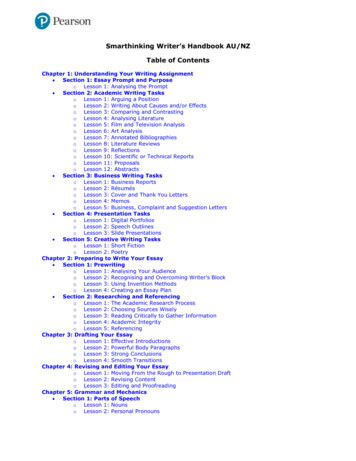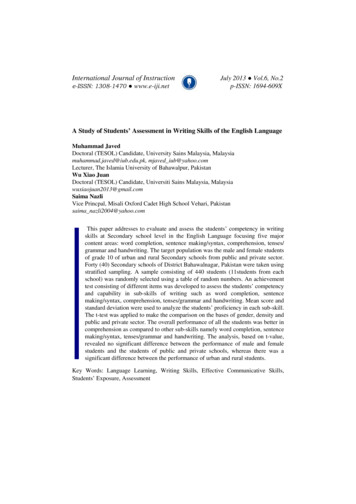
Transcription
A Writer’s Guideto MindfulReadingEllen C. Carillo
A WRITER’S GUIDE TOMINDFUL READINGEllen C. CarilloUniversity of ConnecticutThe WAC Clearinghousewac.colostate.eduFort Collins, ColoradoUniversity Press of Coloradoupcolorado.comBoulder, Colorado
PracticeandPedagogySeries Editor: Mike PalmquistThe Practice & Pedagogy series addresses the teaching, learning, and practice of writing in all itsforms. From Joseph Williams’ reflections on introductions to Richard E. Young’s taxonomy of “smallgenres” to Adam Mackie’s considerations of technology, the books in this occasional series exploreissues and ideas of interest to writers and teachers of writing.The WAC Clearinghouse, Colorado State University Open Press, and University Press of Coloradoare collaborating so that these books will be widely available through free digital distribution andlow-cost print editions. The publishers and the Series editor are committed to the principle thatknowledge should freely circulate. We see the opportunities that new technologies have for furtherdemocratizing knowledge. And we see that to share the power of writing is to share the means forall to articulate their needs, interest, and learning into the great experiment of literacy.Other Booksin theSeriesLillian Craton, Renée Love, & Sean Barnette (Eds.), Writing Pathways to Student Success(2017)Charles Bazerman, Involved: Writing for College, Writing for Your Self (2015)Adam Mackie , New Literacies Dictionary: Primer for the Twenty-first Century Learner (2011)Patricia A. Dunn , Learning Re-abled: The Learning Disability Controversy and CompositionStudies (2011)Richard E. Young, Toward A Taxonomy of “Small” Genres and Writing Techniques for Writing Across the Curriculum (2011)Joseph M. Williams, Problems into PROBLEMS: A Rhetoric of Motivation (2011)Charles Bazerman, The Informed Writer: Using Sources in the Disciplines (2011)
The WAC Clearinghouse, Fort Collins, Colorado 80523-1040University Press of Colorado, Boulder, Colorado 80303 2017 by Ellen C. Carillo, . This work is licensed under a Creative Commons Attribution-NonCommercial-NoDerivatives 4.0 International.ISBN 978-1-64215-027-8 (PDF) 978-1-64215-028-5 (ePub) 978-1-60732-777-6 (pbk.)DOI 10.37514/PRA-B.2017.0278Printed in the United States of AmericaLibrary of Congress Cataloging-in-Publication DataNames: Carillo, Ellen C., author.Title: A writer’s guide to mindful reading / Ellen C. Carillo.Description: Fort Collins, Colorado : The WAC Clearinghouse ; Boulder, Colorado : University Press of Colorado, [2017]Identifiers: LCCN 2017039386 ISBN 9781607327776 (pbk.) ISBN 9781607327783 (ebook)Subjects: LCSH: Reading (Higher education) English language—Rhetoric—Study and teaching (Higher) Academic writing—Studyand teaching (Higher) Reading comprehension—Study and teaching (Higher) College reading improvement programs.Classification: LCC LB2395.3 .C36 2017 DDC 428.40711—dc23LC record available at https://lccn.loc.gov/2017039386Copyeditor: Brandy BippesDesigners: Mike Palmquist and Ashley FreemanCover Art: Joseph A. GerberSeries Editor: Mike PalmquistThe WAC Clearinghouse supports teachers of writing across the disciplines. Hosted by Colorado State University, and supported by theColorado State Univeristy Open Press, it brings together scholarly journals and book series as well as resources for teachers who usewriting in their courses. This book is available in digital formats for free download at wac.colostate.edu.PermissionsCharles Bazerman, “A Relationship between Reading and Writing: The Conversation Model.” Copyright 1980 by the National Councilof Teachers of English. Reprinted with permission.Mike Bunn, “Motivation and Connection: Teaching Reading (and Writing) in the Composition Classroom.” Copyright 2013 by theNational Council of Teachers of English. Reprinted with permission.David A. Jolliffe and Allison Harl, “Studying the ‘Reading Transition’ from High School to College: What Are Our Students Readingand Why?” Copyright 2008 by the National Council of Teachers of English. Reprinted with permission.Anthony Petrosky, “From Story to Essay: From Reading to Writing.” Copyright 1982 by the National Council of Teachers of English.Reprinted with permission.Mariolina Salvatori, “Reading and Writing a Text: Correlations between Reading and Writing Patterns.” Copyright 1983 by the National Council of Teachers of English. Reprinted with permission.Robert Scholes, “The Transition to College Reading.” Copyright 2002 by the National Council of Teachers of English. Reprinted withpermission.Robert J. Tierney and David Pearson, “Toward a Composing Model of Reading.” Copyright 1983 by the National Council of Teachersof English. Reprinted with permission.
Stacey Waite, “On the Occasion of Being Mistaken for a Man by Security Personnel at Newark International Airport” from Butch Geography, published by Tupelo Press. Copyright 2013 by Stacey Waite. Used with permission.Sarah Davis, “The ‘Blurred Lines’ Effect: Popular Music and the Perpetuation of Rape Culture.” Copyright 2014 by Sarah Davis. Usedwith permission.OUP Blog Entries. Oxford University Press. Used with permission.Wendell Berry, “Environmentalists Have Given Up too Much by Not Being Radical Enough.” Copyright Grist.org. Used with permission.Amelia Urry, “If you Think Technology Has no Place in the National Parks, Think Again.” Copyright Grist.org. Used with permission.“The Pace of Modern Life.” Copyright xkcd.com. Used with permission.Derrick Jensen, “Forget Shorter Showers.” Copyright Orion Magazine. Used with permission.
IntroductionWhat is Mindful Reading?Before we get to mindful reading, let’s answer what at first might seem like the simpler question:What is reading? Reading is something we all do every day—we read books, street signs, text messages, blogs, product labels, billboards—but have you ever stopped to think about what happenswhen we read? How does your brain process the marks your eyes see? How are these marks understood as letters, words, and sentences that have meaning? Research has shown that when we read,different regions and systems in the brain play different roles. Neuroscientists at Princeton University, Tanja Kassuba and Sabine Kastner, explain that the visual system and language regions of thebrain work together to translate the marks we see on a page into words we can understand. Did youknow that our eyes hardly move as they do all of this work? We might think that as we read our eyesmove smoothly along the words as we read them, but, instead, our eyes remain largely motionlesssince eyes can only see when they are in this state. Between these motionless periods, our eyes movevery rapidly, jumping along the lines, again with little reference to the words before us (Rayner).Cognitive psychologists, who research the brain, have conducted various experiments to studythe power of reading. For example, in his book Such Stuff as Dreams: The Psychology of Fiction,Keith Oatley argues that reading fiction (stories) provides such a vivid simulation of real life that thebrain processes a detailed description of an experience one may find in a novel in the same way itwould process the actual experience. Equally interesting is that Raymond A. Mar and his colleagues,including Oatley, conducted experiments that ultimately showed that people who read fiction aremore empathetic than those who do not. Mar and his colleagues argue that this is the case becausefiction offers the unique opportunity to identify with characters, something that fiction readers takewith them beyond the text and into real life situations.As these brain studies suggest, reading can be an escape into another world that often seems asreal as the one around you. But not all reading is peppered with colorful characters and excitingscenes. While you may end up reading some fiction in your English classes, you will likely read a lotof textbooks in college, too. Of course, this kind of reading is not intended to send you into anotherworld, but meant to inform you or teach you something in a more straightforward manner. Fictionand textbooks won’t be the only reading you’ll do in college. You may also be asked to read difficultpeer-reviewed articles, dense scientific reports, business memoranda, and editorials, among otherv
vi Introductionkinds of texts. You will, therefore, need to figure out how to move among all of the different types oftexts you will encounter and how to adjust your approach so you can get the most out of each text.This is where the “mindful” in “mindful reading” comes in. If you have heard the word “mindful” it may have been in a different context, perhaps in reference to meditation, yoga, or Buddhism.When you are mindful you are “in the moment.” You are not distracted or focused on anythingelse. Being mindful is a pretty tall order when there is so much around to distract us—smartphonesringing, text messages buzzing, screens blinking. Still, practicing mindful reading by being aware ofhow you read can help you develop as a reader and—by extension—as a writer. Reading mindfullymeans paying attention not just to the content of the text—what it says—but rather to the processof reading itself by adjusting how you read based on what the piece asks of you. Skimming something—a newspaper, perhaps—may be a perfectly suitable approach in a particular situation. Skimming, however, might not be the best approach when you are expected to answer specific questionsabout a more complex reading or connect it to other complex readings, as you will likely have to doin your college classes.Mindful reading acts as a framework that is intended to remind you of the importance of becoming an active reader who makes careful and deliberate decisions about the reading strategiesyou might use. As you mindfully read, you will be learning about reading and also about yourselfas a reader. These experiences can help you become an altogether stronger reader not just in thiscourse but beyond it.How this Book Enriches and Expands Your Reading Ability“But,” you may say, “I know how to read! I wouldn’t have made it this far if I didn’t.” You are right—toan extent. You certainly know how to decode language in the ways reading is described in the opening to this introduction, and you can understand certain types of texts. But, in college, expectationschange, including those associated with reading. You will need to work on your reading for severalreasons:1. You will be faced with more reading.2. The types of reading you will be assigned will vary drastically depending on the disciplineand the course.3. You will be expected to read more complex texts.4. You will be asked to complete more complex tasks associated with your reading.These reasons suggest why it is important that you gain practice in different reading strategies.
Introduction viiAs you move through your academic career you will likely find (if you haven’t already) that textsfrom different disciplines demand different types of reading. While you may be used to reading literature in a certain way, that reading approach might not lend itself to that dense biological researchstudy you have been assigned to read. Or, you may find that your go-to reading strategy of highlighting with that yellow marker might not cut it when faced with a jargon-ridden historical essay meantonly for expert historians or that equally (but for different reasons) difficult psychology textbook.A Writer’s Guide to Mindful Reading seeks to prepare you for all of these reading experiences byhelping you develop a repertoire or toolkit of reading strategies to which you can turn so you areprepared to effectively read a range of texts as you move through the disciplines.Although you may be using this textbook in an English or writing course, these reading strategies are useful across disciplines. In fact, I taught one student who regularly spoke about howbecoming aware of and practicing various reading approaches within the mindful reading framework helped him to understand word problems in math class (math!). In an evaluation of one ofmy courses, another student described his use of the “Says/Does” approach in a History course.This reading strategy, which you will learn about in Chapter 2, involves going paragraph by paragraph noticing what each paragraph says—its content—and what each does—its function. Thestudent explains, “In American Studies, I decided to try the ‘Says/Does’ approach when readingthe Dred Scott case proved difficult due to its word choice. Breaking it down paragraph by paragraph proved very useful. If I see another cryptic piece in further history classes, I would returnto the method.”Further developing your reading abilities is important work as recent studies have shown thatcollege students and young adults, generally, struggle in this area. A study entitled “America’s SkillsChallenge: Millennials and the Future,” published in 2015 by Educational Testing Services (ETS)found that “one half (50%) of America’s millennials,” defined as those born after 1980 who were16–34 years of age in 2012 “failed to reach level 3 in literacy” (11), which tests how well respondents“identify, interpret, or evaluate one or more pieces of information, and often require varying levelsof inference” (48). In other words, it tests how well one reads. Only 50% of American millennialsmet this minimum benchmark, highlighting the difficulty young adults have working with “piecesof information,” what we might call sources or informational texts, which make up a large part ofcollege-level reading material. Additionally, the SAT Verbal/Critical Reading Portion, as well as theACT test, which is also often used for admissions and placement have shown declines in students’reading abilities: “In 2015 [the date of the most recent published study], the average score on the SATverbal test was near historic lows” (par. 3). Based on 1.9 million students who took the ACT test in2015, 46% of students met ACT’s “college ready benchmark” on the Reading section, a decline fromthe 51% who did so in 2006. Most recently, in late 2016, the Stanford History Education Group at
viii IntroductionStanford University published a study entitled “Evaluating Information: The Cornerstone of Civic Online Reasoning,” which reports that middle-school through college-age students are “easilyduped” when “it comes to evaluating information that flows through social media channels” (4).Accurately reading, understanding, evaluating, and incorporating credible information into one’swriting is, of course, an important aspect of college-level writing.Despite these dismal statistics, and although you still have a lot to learn and practice, your previous reading experiences can be useful to your current, college-level reading assignments. Completing the following exercise will help you reflect on these earlier experiences.Ponder ThisTake a moment to think back to something that you recently chose to read, something easy that posed no problems for you—maybe a blog entry, a novel, a newspaper article. Jot down a few sentences about that experience. You probably didn’tthink much about how you read it at the time, why you read it, or how you read it,especially if you chose it. The reading process likely never entered your mind. Now,think about something you read recently that you found was difficult—whetherbecause of its vocabulary, its genre (i.e. the type of text it is), or its subject. Jot downa few sentences about that experience. I bet you became more self-conscious aboutyour reading process. You may have decided to give up altogether or you mighthave used some strategies to help you work through the difficulty. You may haveused a dictionary to help you understand some words or maybe you followed a hyperlink to another source hoping that would offer some guidance. These strategiesare helpful, and they are ones that you may already have extensive practice using.This textbook will give you additional strategies, additional ways of reading, so thatyou never have to give up on a text, no matter how difficult, no matter the discipline, no matter the challenges that face you.Won’t This Kind of Reading Take Longer?Now that you know that this textbook will give you strategies for reading and encourage you to taketime to reflect on—think about—your reading, you are probably wondering: “Won’t this kind of
Introduction ixreading take longer than just reading?” The answer is “not necessarily.” Here’s why: When you arereading mindfully and in the present moment, you realize immediately when you begin to zone outand you consider what you can do in that moment to refocus. You ask yourself questions about whyyour mind drifted. Perhaps you need a different reading strategy—one that will make the readingmore relevant or comprehensible. And yes, it may take a minute to regroup, shift gears, and put another strategy into play, but you won’t lose the time you would have lost had it taken you 15 minutes(and 8 pages!) to realize that you zoned out and have no idea what you just read, an experience wehave all had.At first, being mindful may seem unnatural and even tedious at times. You may wonder, “Whycan’t I JUST read without doing all of this extra work?” Here’s why: Research shows that in orderto transfer—or apply—what is learned in one course to another, students need to actively thinkabout—or reflect on—what they have learned. In other words, they need to be mindful. If studentssimply go through the motions and complete assignments and readings without any awareness ofthem and their uses beyond the present class, students are not likely to draw on those earlier educational experiences when faced with similar experiences later in their academic careers and beyond.So, taking the time to reflect on what you are learning about reading and about yourself as a readeras you move through the selections in this book will save you time later since it will position youto apply all that you learn here to other courses and contexts. This reflective work will allow youto more easily see connections between the activities and assignments included in this book andthose you will encounter outside of this course. Plus, the truth is that it is impossible to “just” read.Whether or not you pay close attention to the reading process, you are still unconsciously makingdecisions when you read. You are choosing to pay closer attention to certain parts of the text, youare slowing down in some moments, speeding up at others, maybe skipping some parts altogether.This textbook is simply asking you to become more aware of those habits and strategies; it’s enriching and adding to them; and it’s positioning you to consciously bring them with you to courses andcontexts beyond this class.Speaking of how this work can help you beyond your present course and even beyond schoolaltogether, students in my classes regularly mention how what they learn about reading helps them“read” the world around them. One student explained that just as she was expected to read differentviewpoints on the same topic, she now “watch[es] both NBC and Fox to get different perspectives.”At first glance this example may not seem to have anything to do with reading, but the student is describing how she reads these perspectives in relation to each other, recognizing that each has its ownbiases. This student will not simply accept what she hears or reads, but will deliberately consider andcompare that information to other ideas and perspectives she encounters. That consciousness, thatawareness, is what mindful reading seeks to foster.
x IntroductionWhat is “Academic Writing”?So far, this book has talked a lot about reading as if forgetting that it is a “writer’s” guide tomindful reading. This has probably left you wondering, “What kind of writing will we be doing?” This book engages you in what is often called academic writing. You might think aboutacademic writing as an ongoing scholarly conversation. In fact, it has become common to usephilosopher and rhetorician Kenneth Burke’s description of a conversation as a metaphor foracademic writing:Imagine that you enter a parlor. You come late. When you arrive, others have longpreceded you, and they are engaged in a heated discussion, a discussion too heated forthem to pause and tell you exactly what it is about. In fact, the discussion had alreadybegun long before any of them got there, so that no one present is qualified to retracefor you all the steps that had gone before. You listen for a while, until you decide thatyou have caught the tenor of the argument; then you put in your oar. Someone answers; you answer him; another comes to your defense; another aligns himself againstyou, to either the embarrassment or gratification of your opponent, depending uponthe quality of your ally’s assistance. However, the discussion is interminable. The hourgrows late, you must depart. And you do depart, with the discussion still vigorouslyin progress.I bet if you take a few minutes you can come up with an instance in which you walked into aroom—like the parlor above—to find a conversation already in progress. Maybe this happened toyou at work or at lunch with friends. You arrived to see that folks were already well into a discussion. You likely didn’t jump right in, but, instead, you took a minute or two to get a sense of theconversation, what they were talking about, and who was saying what. Only then—after listeningand evaluating the situation—did you participate. In the “conversation” of academic writing, youwill be expected to do precisely that, which you have likely already done many times in your life.You will need to “listen for a while” to what others have said about the subject until you “[catch]the tenor of the argument,” to use Burke’s words. Ultimately, you will have to contribute something to the discussion; you will have to “put in your oar” so to speak. But it doesn’t end there. Youwill then need to address how others respond to your contribution and you may need to qualifyor revise it. Others will likely respond again, you will do the same, and so on. In less metaphoricalterms, many of the writing assignments in this book expect you to read (and understand) whatothers have said about a subject before you can think alongside them and write a response ordevelop an argument.
Introduction xiThe Importance of Annotation to Academic WritingAnnotation, marking up a text, is a first step toward participating in academic conversations. Whenyou annotate, you write as you read by responding to that reading in the form of notes, comments,and questions in the margins of your text. This may be done digitally or by hand. These marginalnotes represent the initial ways in which you are participating in the scholarly conversation withthe author of the text. Your initial contributions to the conversation can be expanded to help youdevelop more detailed responses in the form of longer, more formal writing assignments, which willlikely demand that you qualify and revise those responses as you continue to participate in scholarlyconversations. Because annotation requires that you write as you read, it might be thought of as abridge between those two practices. In fact, research has shown that simultaneous practice in reading and writing leads to stronger abilities in both.Digitally Annotating the Selections in this TextbookYou have several options for digitally annotating them, including the following:1. You may use the Adobe Acrobat Reader, which is available for free download at https://get.adobe.com/reader. This program will allow you to highlight and add sticky notes to any ofthe readings printed in the textbook. You can save your documents with the notes and sharethem.2. You may download an annotation management system like Diigo for free at https://www.diigo.com. The basic, free service will allow you to annotate up to 100 webpages and PDFs.3. You may add sticky notes to any webpage with https://www.mystickies.com. You will need tosign up (it’s free) and install a Chrome Browser extension.4. You may download https://web.hypothes.is, an open-source digital annotation managementsystem that allows you to annotate anything on the Web and share those annotations. Youwill need to register for an account and install a browser extension. The “Education” sectionof the website includes a “Quick Start Guide for Students” and other useful resources.Reading and Writing to Make MeaningNotice that throughout this introduction, both reading and writing are described as active, creative practices. This textbook imagines reading as an exercise in creating meaning, not finding it.
xii IntroductionTake a minute to consider the difference between the acts of creating and finding. Conceivingof reading as finding meaning suggests that the text holds the meaning and it is the reader’s jobto simply locate the meaning therein rather than take part in how the text’s meaning is created. When we think about reading as an act of creation, we might imagine a reader who bringsher background, previous reading experiences, culture, religion, and worldview with her to thereading. All of this contributes to how that reader creates meaning from the text. Think about itthis way: If meaning was located (or hidden) in a text then each time you read that text it wouldmean the same thing to you. Every reading experience of the text would be exactly the same. Thisisn’t the case, though. Have you ever read a story when you were much younger and returnedto it a decade later to find that it means something different to you? The story hasn’t changed;it’s you who has changed! That change affects how you make or create meaning from the story.Sometimes, unfortunately, that change means that you end up disliking a book you once lovedor it could mean the opposite and you end up loving a book you couldn’t stand as a youngster.Neuroscientist Richard Restak explains this phenomenon as follows: “As a result of the lifetimeplasticity of the brain, we’re literally a different person than the person who read the book the firsttime.” No matter the kind of feelings that the act of rereading may evoke, this very scenario—thattexts mean differently to us at different times—demonstrates that the reader and the text createmeaning together.Along the same lines, you will likely notice that as you participate in class discussions aboutthe reading selections in this book, your classmates may have noticed different elements thanyou. They may think the piece means something different. They are not wrong. The selection doesmean differently to them because their reading experience has been different from yours. Becauseof qualities they bring to the text—their background, previous reading experiences, culture, religion, worldview, and so on—they paid attention to different aspects of the text and so came awaywith different understandings of it. That’s not to say that anything goes when reading since thetext must support all readings, but rather that meaning does not reside in the text alone.How This Book Is OrganizedBy way of conclusion, this section provides an overview of how A Writer’s Guide to Mindful Reading is organized. The book is divided into two parts with Chapter 5 (in Part Two) serving as abridge between them. Part One includes the instructional apparatus: it teaches you about thereading strategies, provides writing instruction; and explains multimodal composing. Entitled
Introduction xiii“Readings on Reading,” Chapter 5 is comprised of selections on the subject of reading, whichwill support your understanding of the very concept of reading and set you on a path towardbecoming a more reflective reader. All of the readings in Chapters 6-10 address technology andits relationship to some other idea or concept (e.g. Gender and Technology) and are accompaniedby questions and long writing assignments. These assignments will help you understand, respondto, and synthesize the readings, as well as apply ideas and concepts within them. Parts One andTwo, however, are not totally distinct. As you are asked to complete the assignments throughoutPart Two, you are directed to the chapter in Part One that can help you complete each assignment.For example, if an assignment asks you to complete a rhetorical reading, a link in that assignmentprovides the chapter number from Part One in which rhetorical reading is described. As youmove between the two parts of this book, learning and applying the reading strategies while writing in response to the included readings, you will become that mindful reader who is prepared toengage the range of texts you will encounter as a college student and beyond. To further supportyour understanding of the terms and concepts associated with mindful reading, a glossary isincluded at the end of this textbook. Words that appear in boldface throughout this textbook areincluded in that glossary.A Note about the Links to ReadingsIn many cases rather than providing you with the full text of a reading you are provided with a linkthat takes you directly to the reading online. Please note that in many instances you are reading aselection on a website, such as The New Yorker or Wired, that requires a subscription after you visita certain number of times. Keep this in mind as you are working from those readings.A Note about AccessibilityThis textbook strives to be accessible to a diverse readership by offering a flexible user experience.The textbook is available in different formats, including ePub. In addition, the textbook containsa navigable table of contents, is searchable, and allows viewers to adjust the size of the text andother textual elements using the “zoom” feature while reading. As explained in Chapter 2, the“read aloud and paraphrase” reading strategy can be modified for deaf readers. Please contact thepublisher with any additional questions about acc
This is where the “mindful” in “mindful reading” comes in. If you have heard the word “mind-ful” it may have been in a different context, perhaps in reference to meditation, yoga, or Buddhism. When you are mindful
